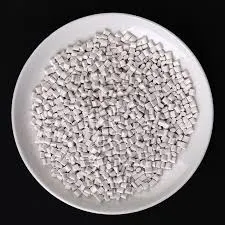Color Concentrates for Plastics Enhancing Aesthetics and Performance
Color concentrates play a pivotal role in the plastics industry, providing not only aesthetic appeal but also functional benefits to a wide range of plastic products. These concentrated colorants are typically produced by mixing pigments or dyes with a resin carrier, creating a uniform, highly concentrated product that can be easily blended into various plastic formulations. This article explores the significance, types, applications, and benefits of using color concentrates in plastics.
Significance of Color Concentrates
The demand for visually appealing and high-performance plastic products has surged in recent years, driven by consumers’ preferences for colorful and innovative designs. Color concentrates help manufacturers meet these demands by allowing for precise color matching and consistency in production. They enable the customization of colors to match branding requirements while ensuring that the color remains stable under various environmental conditions, such as UV exposure and heat.
Types of Color Concentrates
Color concentrates can be categorized into several types based on the form of the colorant and its intended application
1. Masterbatches These are solid or liquid color concentrates that can be mixed with the base resin before the extrusion or injection molding process. Masterbatches provide an efficient method for coloring plastics, allowing for quick changes in color without significant downtime.
2. Liquid Colorants These concentrated liquid formulations can be easily added during the plastics processing stage. The advantages include improved dispersibility and the ability to achieve darker colors without the need for large quantities of pigment.
3. Additive Color Concentrates In addition to color, these concentrates may include other performance-enhancing additives, such as UV stabilizers, anti-static agents, or flame retardants. This dual functionality makes them particularly valuable for specialized applications.
Applications of Color Concentrates
Color concentrates are widely used across various industries due to their versatility and effectiveness. Some common applications include
color concentrates for plastics

- Packaging Color concentrates add vibrancy and appeal to packaging materials, making products more attractive on store shelves
. They can also help indicate product freshness or improve shelf life through UV protection.- Consumer Goods Items like toys, household products, and electronic devices often utilize color concentrates to achieve visually appealing aesthetics that resonate with consumers.
- Automotive In the automotive industry, color concentrates are used to provide durable and weather-resistant colors for interior and exterior components, ensuring long-lasting performance.
- Construction Color concentrates are used in the production of materials like vinyl siding, roofing, and pipes, enhancing both appearance and durability.
Benefits of Using Color Concentrates
Using color concentrates in plastic manufacturing offers several advantages
- Consistency Color concentrates ensure color uniformity across batches, reducing the risk of color variations that can occur with traditional coloring methods.
- Efficiency Since they are highly concentrated, color concentrates require smaller quantities, thus reducing the waste and handling issues associated with bulk pigments.
- Customization Manufacturers have the flexibility to develop custom colors or match specific shades required by clients, enabling greater creativity and differentiation in product offerings.
- Performance Many color concentrates are designed to enhance the physical properties of plastics, providing added benefits like improved UV resistance, thermal stability, and longevity.
In conclusion, color concentrates are an essential component in the plastics industry, providing manufacturers with the tools they need to produce vibrant, high-quality products that meet market demands. With the continued growth of the plastics sector and evolving consumer preferences, the role of color concentrates is poised to expand, contributing to the innovative and aesthetic advancement of plastic products across various industries. As technology advances, manufacturers can expect even more efficient and effective color concentrate solutions, further enhancing the potential of plastics in our daily lives.

